Curiosities about geology | Carbon Vegetal an alternative Energy for the Future
Hello friends, welcome to my second installment of the series of publications that I have called Curiosities on geology, the next publication that I will present as the main theme of vegetable carbon, which is considered today as an alternative energy for the future of humanity , in this article you can observe a very interesting content, where basic concepts are defined, which is a carbon? , what is its origin, how it is formed and also what are the types of coals that exist, I hope this post is of your interest and if so vote and comment, remember that the science of geology is the history that it defines the beginning of our existence.

WHAT IS CARBON?
Carbon is a sedimentary rock formed by accumulations of vegetable remains in areas with large amounts of stagnant water. It is a fossil fuel, black and rich in carbon. It is the most abundant fossil fuel on earth, but most have the drawback that their extraction is very complicated and expensive.
Sedimentary rock: rock formed by the remains of other rocks.
Fosil: rest of an organism or its activity that has been preserved in the rocks.
Carbon is a fossil fuel and is the rest of the altered prehistoric vegetation that originally accumulated in swamps and peat bogs, the energy that plants absorbed from the sun millions of years ago.
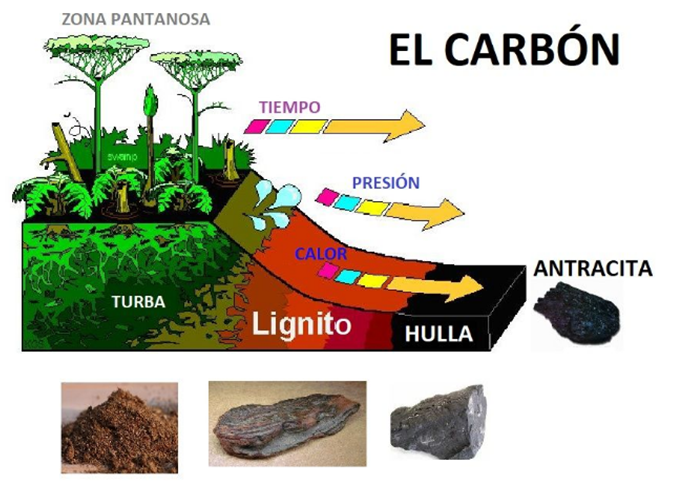
All plants during their lives store solar energy through a process known as photosynthesis. When plants die, this energy is usually released while the plants decompose. Under conditions favorable to carbon formation, the decomposition process is interrupted, preventing the release of stored solar energy. This energy will be the energy of the coal when it is formed.
In the image above you can see how the different types of coal are formed. Then we will see the types of carbon.
SOURCE OF CARBON
The origin of the current coal began during the carboniferous period, known as the first carbon age, between 290 and 360 million years ago.
The accumulation of mud and other sediments, along with movements in the earth's crust, known as tectonic movements, buried bogs and peat bogs (wetlands) often at great depths. With the burial, the plant material was subjected to high temperatures and pressures. This caused physical and chemical changes in the buried vegetation, transforming it into peat and then into charcoal.
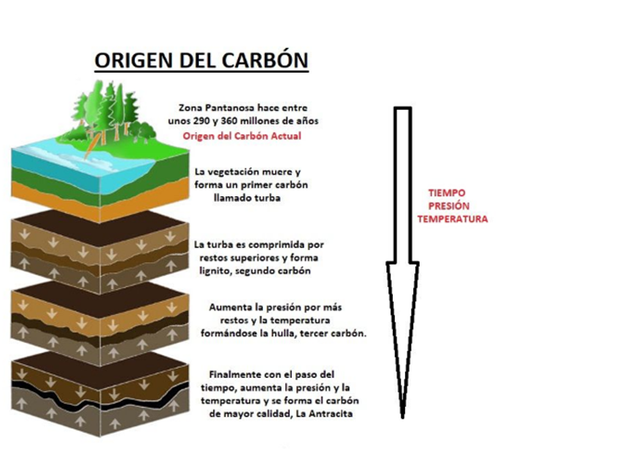
CARBON FORMATION
To explain the formation of carbon the first thing is to know how sedimentary rocks are formed, because as we saw earlier, coal is a rock of this type.
Sedimentary rocks are those that are formed by the erosion of the relief of nature by the action of wind, water and living beings.
This erosion causes small fragments (of rocks, animals or vegetables) to be separated and transported from the place where they are detached to other places, mainly seas and oceans, where they accumulate in the form of layers, gemerally horizontal, called sediments or sediment strata.
It is also possible that the erosion does not transport the remains to other places and also forms sedimentary rocks in the same place, as is the case of the coal that we will see later.
With the passage of time, the weight of the upper eroded materials crush the lower ones and the latter become more compact (uniting) forming the sedimentary rocks (formed by sediments).
Conclusion sedimentary rocks are those formed by the remains of other rocks, animals or plants. In the case of coal we are interested only in the forms of vegetable remains.
The coal is the result of the accumulation of large remains of vegetables (leaves wood and bark) in places with large amounts of stagnant water, such as swamps, and over time end up becoming carbon.
The stagnant water is poor in oxygen and this favors that the dead plants do not decompose in their entirety favoring the process of slow formation of carbon with the passage of time in layers or sedimentary strata.
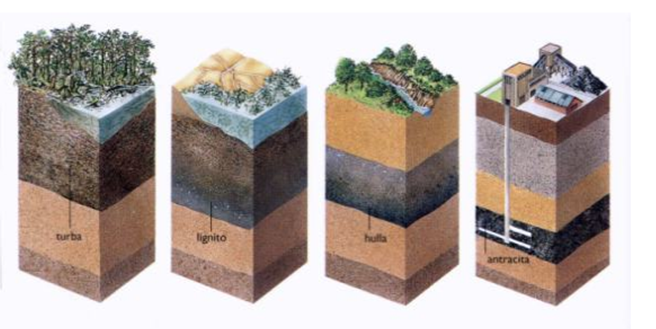
These remains of vegetables are formed mainly by hydrogen, oxygen and carbon and not being in contact with air, thanks to stagnant water, they lose hydrogen and oxygen by putrefaction and increasing their amount of carbon. That is why carbon is rich in carbon and is used as fuel.
The amount of each type of carbon is determined by the temperature and pressure to which the layers of plant remains have been subjected in their formation, as well as by the time of formation, which we refer to as "organic maturity". carbon has more carbon and therefore it is considered of higher quality. Later we will see the types of carbon.
As seen so far, we only found carbon in places where there was a lot of vegetation in swampy areas in the carboniferous period.
TYPES OF CARBON
Carbon is classified according to its calorific power (power to produce combustion or burn). The more proportion they have of carbon, the better it will be. According to this we have -.
- Peat: It is the worst quality and therefore the least carbon has (just 55%). It is the first carbon that is formed has a brownish green color and at the time of extraction still contains a lot of water, so it must be dried before being used as fuel. When it burns it releases a lot of smoke and ashes. It is used as low quality fuel, in gardening to improve the soil due to its high capacity to retain water and even to paint.
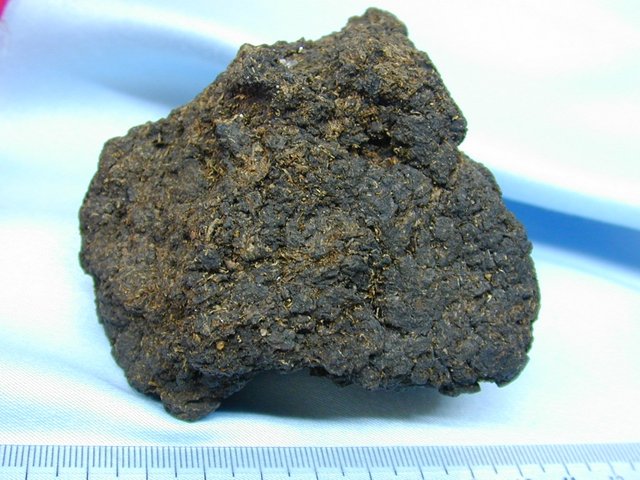
- Lignite: When the peat is compressed, the lignite is formed. It is black and usually has a texture similar to the wood from which it comes. It has a carbon percentage between 60% and 75%. It is a medium quality fuel, it is a coal formed a few tens of millions of years ago. It is used as fuel to generate electricity
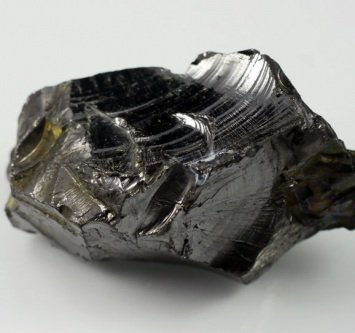
- Coal: Coal contains between 75% and 85% carbon and is hard, black, opaque and fatty. It is formed when the lignite layers are compressed in the primary era and it is the most abundant type of coal and the most commonly used coal of stone. It has a high calorific power and that is why it is used mainly for the Thermal Power Plants in the production of electricity. It is also used to produce coke coal used in blast furnaces. The elaboration of coke generates in turn many derivatives that are used in the chemical industry; benzene, naphthalene, phenols, cresols, among other chemicals.
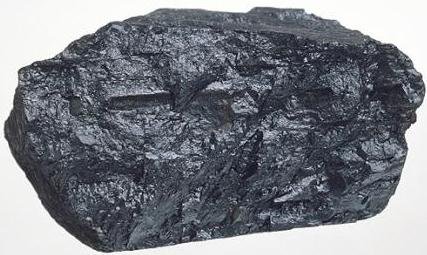
- Anthracite: It comes from the transformation of coal. It is the best of all types of carbons with a percentage in carbon that can reach even 95%. It is the least polluting (it emits little smoke) and is the one with the highest calorific power. It is black, bright and very hard (hard to scratch). It is used in heating boilers for homes and to generate electricity, but due to its cost is currently being displaced by natural gas. Its main use today is to produce coke.
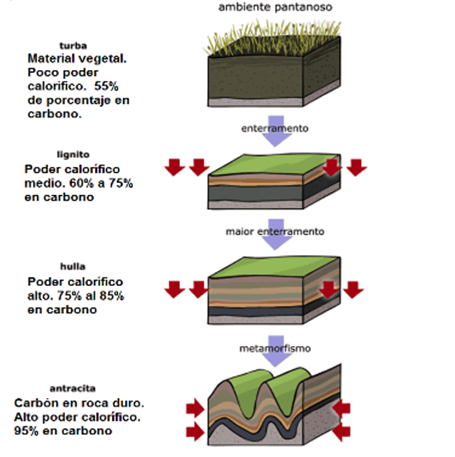
Remember that all fossil fuels eventually disappear, so it is essential that we use them as effectively as possible.
References Bibliography :
- https://en.wikipedia.org/wiki/Charcoal
- https://www.webmd.com/vitamins-and-supplements/activated-charcoal-uses-risks
- https://www.britannica.com/science/charcoal
- https://draxe.com/activated-charcoal-uses/
- Dawson, Andrew. "Activated charcoal: a spoonful of sugar". Australian Prescriber. NPS MedicineWise. Retrieved 19 March 2016.
- "Treating flatulence". NHS. NHS UK. Retrieved 27 May 2012.
- "charcoal: powdered, compressed, willow and vine". Muse Art and Design. Muse Art and Design. 7 September 2011. Retrieved 27 May 2012.
- Johannes Lehmann, ed. (2009). Biochar for Environmental Management: Science and Technology. Stephen Joseph. Earthscan. . Retrieved 30 Dec 2013.
You received a 10.0% upvote since you are not yet a member of geopolis.
To read more about us and what we do, click here.
https://steemit.com/geopolis/@geopolis/geopolis-the-community-for-global-sciences-update-4
If you do not want us to upvote and comment on your posts concerning earth and earth sciences, please reply stop to this comment and we will no longer bother you with our love ❤️
You got a 3.92% upvote from @upmewhale courtesy of @lisbethferrer!